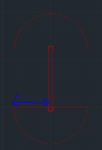Hawaslsh
Full Member level 3
- Joined
- Mar 13, 2015
- Messages
- 164
- Helped
- 5
- Reputation
- 10
- Reaction score
- 7
- Trophy points
- 1,298
- Location
- Washington DC, USA
- Activity points
- 3,422
Hi all,
Had a series of questions just wanted to run by, sorry if they are pretty beginner.

When using a quarter wave impedance match, in this case for a patch antenna, it doesn't matter how long (disregarding real loss) the input transmission line is? Will the quarter wave match perform as expected with any length?

Second question, I'm trying to make some planar measurements of these patches, so I need to make a GSG probe transition to microstrip. The picture above shows my transition geometry, i use a large λ/4 radial stub to mimic a ground around my center freq. Should that λ/4 length be the wavelength of the CPW landing pad or the ustrip line?

The coup de grace, the picture above shows the measurement setup i planned on to actually measure the patches. The ultimate goal to determine which patch size / feed process variation resulted in the optimum simulated results. As for calibration, I was going to start with a SOLT cal using a cal substrate. If I saw weird results using the SOLT (due to the CPW to Ustrip transitions), i was going to try a TRL cal in order to set the reference plane on the wafer and include the transition in the cal.
This leads to my last 2 questions: Do you all see any glaring holes or issues here? My eyes have been, and will be, the only ones to have functionally seen this before we spend time and money to both print and measure the antennas. So, a second option would be nice. Lastly, our VNA doesn't have the option to perform a TRL on onboard, does anyone have a handy link to the math behind TRL? You all are much more reliable than google, in these matters :razz:
Thanks in advance,
Sami
Had a series of questions just wanted to run by, sorry if they are pretty beginner.

When using a quarter wave impedance match, in this case for a patch antenna, it doesn't matter how long (disregarding real loss) the input transmission line is? Will the quarter wave match perform as expected with any length?

Second question, I'm trying to make some planar measurements of these patches, so I need to make a GSG probe transition to microstrip. The picture above shows my transition geometry, i use a large λ/4 radial stub to mimic a ground around my center freq. Should that λ/4 length be the wavelength of the CPW landing pad or the ustrip line?

The coup de grace, the picture above shows the measurement setup i planned on to actually measure the patches. The ultimate goal to determine which patch size / feed process variation resulted in the optimum simulated results. As for calibration, I was going to start with a SOLT cal using a cal substrate. If I saw weird results using the SOLT (due to the CPW to Ustrip transitions), i was going to try a TRL cal in order to set the reference plane on the wafer and include the transition in the cal.
This leads to my last 2 questions: Do you all see any glaring holes or issues here? My eyes have been, and will be, the only ones to have functionally seen this before we spend time and money to both print and measure the antennas. So, a second option would be nice. Lastly, our VNA doesn't have the option to perform a TRL on onboard, does anyone have a handy link to the math behind TRL? You all are much more reliable than google, in these matters :razz:
Thanks in advance,
Sami